
You're not imagining it – various iterations of the body shaper have taken over your feed. Who knew this flesh-cinching contraption, once seen as barbaric and unfeminist, would become a wardrobe staple for women?
The shapewear boom stemmed from the rise of athleisure, a trend that inspired many to wear their gym clothes outside the gym – and we’re not talking about ratty T-shirts and shorts. This prompted fitness labels to create shaping lines and birthed new brands that specialize in shapewear.
Today, the latter is a global industry with loads of celebrity capital. Kim Kardashian, Kate Hudson, Lizzo, Beyoncé, and the OG Sara Blakely of Spanx fame have all upped their game through their respective brands, creating body-shaping undergarments worth wearing on their own.
But the more impactful transformation came when many brands decided to make their products inclusive, catering to women of all shapes, sizes, and lifestyles. Suddenly, wearing a body shaper wasn’t something only a CEO, , or politician would do. It is for anybody who wanted to feel good in the clothes they’re in.
Has shapewear gone from feminist foe to every woman’s BFF, helping women love the skin they’re in, too?
A History of Torture
The first body shaper was the girdle, worn by women in ancient Greece. They wrapped firm fabrics like linen, wool, or soft leather around their waists to cinch them and push the breasts up. Corsets were already also common then but became a fashion staple only during the Victorian Era. When Catherine de Medici reintroduced the concept in the 1500s, it became as essential to a woman’s wardrobe and .
This body shaper had boning made with whalebone or wood, giving it a rigid form. Tightly lacing it would cinch the waist and give women curves in all the “right” places. At that time, corsets were full bodices that covered the breasts, but by the mid-19th century, some waists were brought below the bustline.
As , corsets were called a “slow and fashionable poison.” It’s no wonder modern-day actors hate them. Bridgerton, a show set in London’s Regency Era, is said to ban corsets in future seasons. The decision came after star expressed how it put her in a lot of pain. Other actors claimed they had breathing problems and bruising, to
Emma Watson refused to wear this type of body shaper in Beauty and the Beast because she didn’t want Belle to be a “corseted, impossible idea of female beauty.” Another reason was to modernize the character, which says a lot about the feminist view on primitive shapewear styles. Do these views apply to Lizzo’s bodysuits, too?
New and Improved or Same Old, Same Old?
The modern body shaper is just as unforgiving on rolls and folds but a lot kinder on the . Its goal, more than to mold the figure into an hourglass body type, is to create a smooth silhouette.
These days, shapewear also comes in different styles – the bodysuit, shaping shorts, camisole, high-waisted leggings, and smoothing briefs. No need to brace yourself to get into these – just roll them up like any other piece of clothing. Further, technology has allowed manufacturers to create effective, shaping pieces with gentler synthetic fabrics, such as nylon and spandex. Other designs come with a mix of cotton and , which are more breathable.
Now that shapewear is relatively more democratic, more and more women are using them every day. They’re not “special occasion only” pieces anymore. Want to look more svelte in a form-fitting dress? Wear shaping shorts. For a full-body lift, try a bodysuit.
Women from size XS to 6X are now more open to the concept of the body shaper as a fashion essential because it’s no longer as restrictive and painful. Free of the corset’s literal shackles, women are also free to decide for themselves: Do I want to wear a body shaper or not?
Loving the Skin You’re In
Feeling good in your skin comes with patience, lots of positive self-talk, and good habits. Start with a self-care routine that gives you the confidence to show up as you. For glowing skin that complements your favorite outfits, use Vaseline Gluta-Hya Serum Burst Lotion Flawless Glow daily. It contains Hyaluron and GlutaGlow technology, which help even out the skin tone and hydrates from within.
Treating your hair to a fragrant and nourishing wash can also . Try Sunsilk Anti-Dandruff Healthy Strong Shampoo, which cleanses your hair and scalp of flakes. Complete your routine with Rexona Advanced Brightening + Anti Stain Deodorant Roll-On, to keep your underarms odor-free and your favorite shapewear protected from stains.
Cinched and Empowered
Your trendy new bodysuit may have descended from the oppressive corset, but can you blame the kid for the sins of the mother? Innovation has allowed the body shaper to break away from connotations attached to it, and we can only hope brands continue to move in that direction.
Some brands even claim that wearing shapewear in these modern times is a feminist act, which may be a bit much. But while it’s not on the level of having the right to vote or , it’s a conversation worth having. Why is it even a big deal? The existence of debate shows we still have a long way to go when it comes to respecting women’s choices over their bodies.
Despite the impressive strides in technology and, frankly, marketing, shapewear is still a polarizing concept loaded with unsavory history. It’s normal to feel a tinge of guilt as you pull up those tummy-flattening shorts as if you’re betraying your gender. But before you feel like a traitor to all womanity, don’t forget that you’re doing this for you.
Ultimately, if a body shaper makes you feel sexy and empowered in your curves, wear it. You don’t need permission. It's your prerogative.